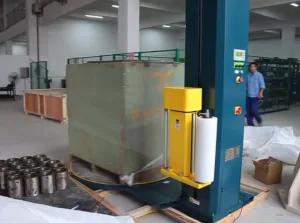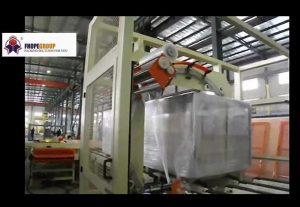Understanding Orbital Stretch Wrappers: Enhancing Load Stability and Protection
In modern logistics and warehousing, ensuring load stability and protection during transit and storage is paramount. An orbital stretch wrapper is a key piece of packaging equipment designed precisely for this purpose. This automated or semi-automated machine utilizes stretch film to securely envelop loads, particularly long or irregularly shaped items that may not be suitable for traditional turntable wrappers. While often used for various loads, specialized versions like horizontal orbital wrappers handle specific product types (see example: orbital stretch wrapper for pallet strapping and wrapping).
Let's delve into the core components and operational principles of these essential machines.
Key Components of an Orbital Stretch Wrapper
Understanding the parts of an orbital wrapper helps appreciate its functionality:

- Frame: The structural backbone, typically robust steel or aluminum, supporting the entire mechanism and ensuring stability during operation.
- Wrapping Ring/Arm: This component moves in an orbital path around the stationary load, applying the stretch film. It's driven by electric motors, ensuring consistent and controlled film application.
- Film Carriage: Mounted on the wrapping ring/arm, this holds the stretch film roll. It often includes a pre-stretch system to maximize film efficiency and load containment force. The carriage precisely controls the film release and tension.
- Film Unwind and Pre-Stretch System: Manages the feeding of the stretch film from the roll. The pre-stretch mechanism (if equipped) elongates the film before application, increasing its yield and securing properties. Tensioners and rollers guide the film smoothly.
- Film Cutter and Clamp System: Automatically cuts the film upon cycle completion and clamps the leading edge, preparing the machine for the next load. This enhances automation and operator safety.
- Control Panel: The operator interface, usually featuring a touchscreen or buttons, allows setting parameters like wrap counts, tension levels, rotation speed, and carriage movement.
- Safety Features: Essential for operator protection, these include light curtains, safety interlocks on doors/gates, emergency stop buttons, and guarding around moving parts.
How Orbital Stretch Wrapping Works
The process involves a coordinated sequence:
- Load Positioning: The product or pallet is placed within the wrapping zone of the machine, often conveyed automatically or positioned manually.
- Cycle Start: The operator initiates the wrapping cycle via the control panel.
- Film Application: The wrapping ring/arm begins its orbital motion around the load. Simultaneously, the film carriage dispenses the stretch film. Depending on the machine type, either the ring moves around a stationary load, or the load is passed through a rotating ring.
- Vertical Movement (if applicable): For pallet loads or taller items, the film carriage may move vertically along the ring/arm or the entire ring assembly may move along the load's length to ensure complete coverage from top to bottom.
- Film Stretching: The pre-stretch system (if present) elongates the film, optimizing material usage and applying consistent tension for secure containment.
- Wrapping Completion: Once the pre-set number of wraps is complete, the machine automatically clamps and cuts the film.
- Load Exit: The wrapped load is then moved out of the machine, ready for shipping or storage.
Operational Parameters and Capabilities
- Film Compatibility: Typically handle stretch films of varying widths (e.g., up to 20 inches or more, depending on the model).
- Wrapping Speed: Ring rotation speeds can often reach up to 60 RPM or higher, enabling efficient throughput.
- Adjustability: Key parameters like rotation speed, film tension, and overlap are usually adjustable to accommodate different load types, sizes, and stability requirements.
- Automation Level: Machines range from semi-automatic (requiring manual load placement/removal and cycle start) to fully automatic integrated systems.
Benefits of Using Orbital Stretch Wrappers
- Enhanced Load Stability: Provides superior containment for uniform and irregular loads, reducing shifting and potential damage during handling and transit.
- Product Protection: Shields goods from dust, moisture, and dirt.
- Improved Efficiency: Automates the wrapping process, increasing throughput compared to manual methods.
- Material Savings: Pre-stretch systems can significantly reduce film consumption while maintaining high load integrity.
- Versatility: Effectively wraps items that are difficult or impossible to wrap on standard turntable machines, such as long bundles (pipes, lumber), furniture, doors, windows, and large pallets.

6 size pallet horizontal stretch wrapping machine Choosing the Right System
Selecting an orbital stretch wrapper involves considering:
- Load dimensions (length, width, height) and weight.
- Required throughput speed.
- Level of automation needed.
- Type of stretch film to be used.
- Specific industry standards or requirements (e.g., see guidelines from organizations like PMMI).
By understanding the components, operation, and benefits, businesses can leverage orbital stretch wrapping technology to significantly improve their packaging processes, ensuring products arrive safely and securely at their destination.
